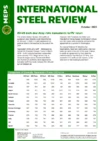US hot rolled coil prices decline sharply after April peak
The US flat product market, which is historically vulnerable to peaks and troughs, is set for a downward correction after MEPS sources described current prices as “too high”.
The consensus view of market participants, in April, was that further rises taking hot rolled coil prices to above US$1200 per short ton were unlikely to be sustained. Buyers commented that it was inevitable that local values would correct downwards, in line with international trends.
Domestic price volatility has been exacerbated by worldwide events in the past few years.
The implementation of trade legislation, particularly Section 232 measures, by the previous US administration, was the start of a new era of protectionism.
Additionally, dealing with the onset and fallout of a global pandemic was unprecedented. This resulted in supply chain difficulties which are still present. More recently, the outbreak of war in Europe led to a temporary price spike in 2022, as fears of steel shortages developed but later eased.
Since the end of last year, US hot rolled coil manufacturers have raised their prices by more than US$500 per short ton, supported by supply-side considerations. Buyers were unable to offer any resistance to the mills’ initiatives.
Maintenance outages during the first quarter contributed to an extension in delivery lead times. Moreover, competitively priced import options were scarce, due to the logistical difficulties of sending material into the country during the winter period and the 25 percent duty for non-quota countries.
Amid solid yet unspectacular end-user demand, most US service centres appeared keen to replenish their inventory levels before the next list price increase was imposed.
Last month, however, hot rolled coil values reached the top of the cycle. Service centres are now in destocking mode. Anticipation of further price reductions means that they are now faced with the prospect of having high-cost inventory on their books, prompting efforts to minimise the extent of their financial losses.
Consequently, purchasing managers in the United States are in no rush to place new orders with the mills. A slight shortening of delivery lead times is already being reported. They can afford to adopt a “wait and see” position.
US steel manufacturers are likely to be forced to make additional price concessions to maintain the strength of their order books through the summer. However, several factors provide them with cause for optimism.
US mill capability utilisation remains relatively low at approximately 75 percent, year-to-date. The introduction of planned new capacity, particularly from scrap-based producers, has been slow. This, combined with the continuing absence of competitively priced imports, should prevent substantial oversupply.
Moreover, further production cuts during the forthcoming summer holiday period are likely, even if they are not officially announced.
Steel consumption in the United States is unlikely to improve, to any great extent, in the short-to-medium term. Economic measures, introduced by the Federal Reserve earlier in the year, will cool down activity.
Nevertheless, end-user demand is holding up well. Any fulfilment of the eagerly anticipated infrastructure measures and a focus on green initiatives in the energy sector may support steel prices.
Speculation is growing that US hot rolled coil basis values will fall to between US$800 and US$900 per short ton in the next few months. Steelmakers will be aiming to minimise the extent of any price erosion.
Further supply control measures are expected to ensure that prices remain above historical levels and, in turn, keep mill profit margins in positive territory.

Source:
International Steel Review
The MEPS International Steel Review is an essential monthly publication, offering professional analysis and insight into carbon steel prices around the world.
Go to productRequest a free publication





